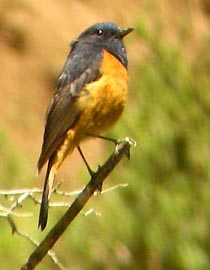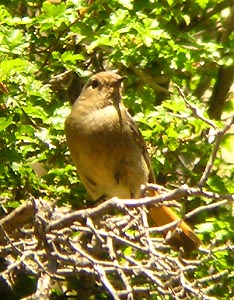| The common and widespread species — and the "basic" redstart for learning
all others — is Black Redstart Phoenicurus ochruros. It is
a colorful species found in open country and light woodlands at all elevations
we visited, including rocky outcrops and road cuts up to 12,000' elevation.
It is often found perched on ruins of old adobe (far right). I understand
this widespread Eurasian species first colonized Britain after WWII, using
bombed-out rubble. These shots are of the race rufiventris of the
Qinghai Plateau. |
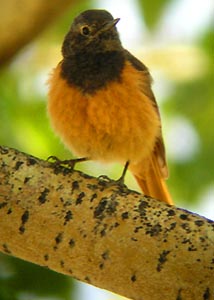 |
 |
|
|
Most redstarts are in the genus Phoenicurus but three — two
of them rushing water specialists — are in monotypic genera. These two
foraged along the rushing river next to our campsite in Huzu Bei Shan National
Park (below, left), a habitat also frequented by two species of dipper,
including White-throated Dipper Cinclus cinclus (below, right),
and one Phoenicurus redstart.
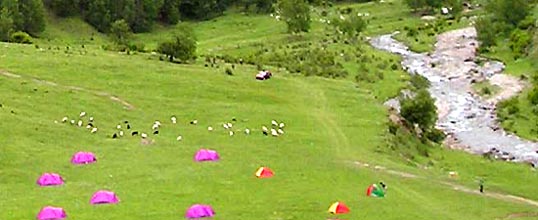 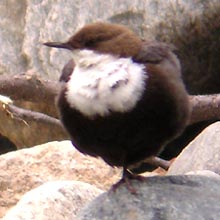
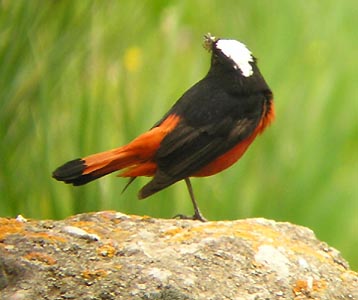
|
White-capped Water Redstart Chaimarrornis leucocephalus
(left) is the most conspicuous. It is also one of the few redstarts in
which the adult male and female are similar in appearance. It is a widespread
bird along roaring rivers in the Asian highlands, and I have previously
encountered it in north India. |
| Likewise, Plumbeous Redstart Rhyacornis fuliginosus (right)
is widespread. In fact, I took this photo of a female in Kashmir back in
Aug 1978. We saw a female from our Chinese campsite but not the quite different
male: he is entirely slaty-blue with chestnut tail. |
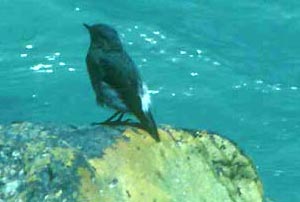
|
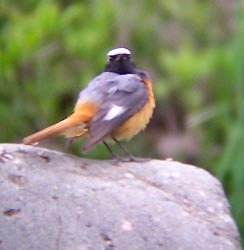 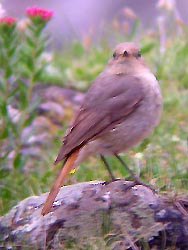
|
The riverside Phoenicurus was Hodgson's Redstart P.
hodgsoni (male & female, left) whose breeding range is limited
to west-central China. Both adults frequented riverside rocks from which
they made short fly catching sallies, often quivering their tails on alighting. |
|

|
The thick forests at Wulsinghan (left), a montane resort at 5000' elevation
north of Beijing, was the habitat of White-bellied Redstart Hodgsonius
phaenicuroides (right). This species is a real skulker and very difficult
to see, let alone photograph! We heard it singing commonly but glimpses
were very few. It is slim and long-tailed, fans its tail often (the tail
was rusty in the base), and is overall a deep slaty-blue with a hard-to-see
white belly. |
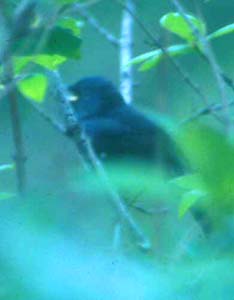
|
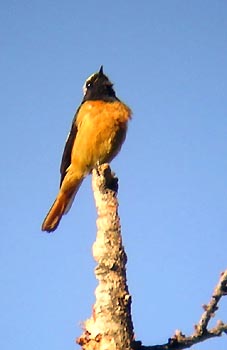
|
Much more conspicuous in the same habitat — but sitting up on treetops
with a commanding view — was Daurian Redstart P. auroreus
(left & right). Its a gorgeous performer in the highlands of east Asia,
ranging from s. Siberia to Tibet. It winters in s.e. Asia and Japan. |
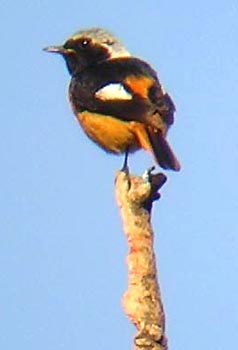
|
|
|
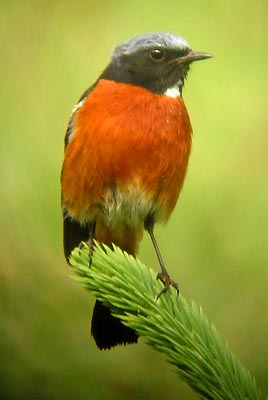
|

|
| Aspen glades at the edge of fir forests at 8000' elevation in the mountains
north of Xining in Qinghai Province, north-central China, is the idyllic
habitat for a drop-dead gorgeous creature: White-throated Redstart P.
schisticeps (above & right). The male's white throat can be hard
to see except in a frontal view, but it adds little to this little beastie.
"Mountain Gem Redstart" would be a much better name. We saw much breeding
activity during our June visit; this male was carrying food to a hidden
nest. |
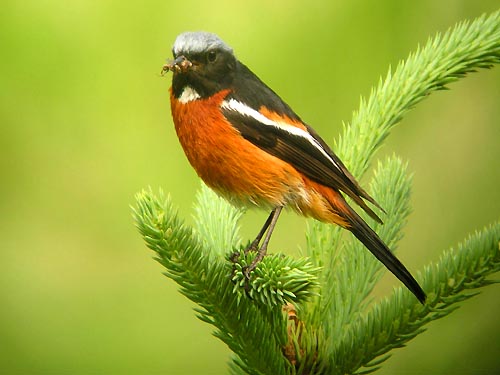
|
|
|
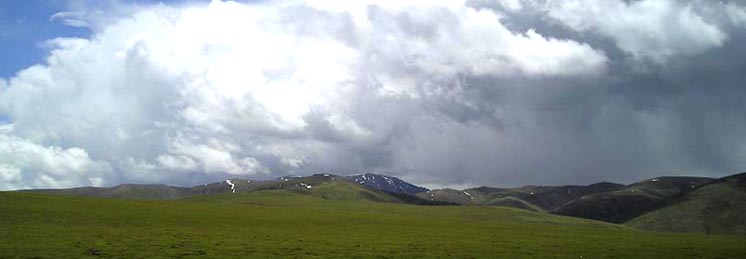
| Its the wildest crags at the highest elevation — like the alpine tundra
on Rubber Mt. Pass, above, at 12,481' elevation [3718m] — that's the place
for White-winged Redstart P. erythrogaster (right). Its old
name was "Güldenstädt's Redstart," a word that has two double-omlots
in it and was a real mouthful if you tried to put your best Germanic accent
to it. A stunner — our views were a bit brief and distant. |
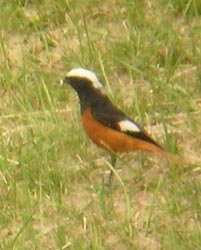
|
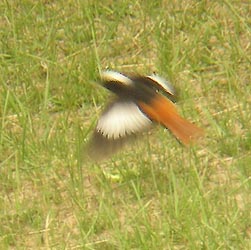
|
|
|
 Our
final two redstarts live in unexpected patches of scrub in dry, rocky,
remote canyons high on the Qinghai-Tibetan Plateau. This canyon (left)
is dubbed "Paul's Canyon" for Paul Holt who discovered the site near the
south shore of Qinghai Lake. Our
final two redstarts live in unexpected patches of scrub in dry, rocky,
remote canyons high on the Qinghai-Tibetan Plateau. This canyon (left)
is dubbed "Paul's Canyon" for Paul Holt who discovered the site near the
south shore of Qinghai Lake. |
|
The common redstart here is Blue-fronted Redstart P.
frontalis: male, female, and baby (below). This is a widespread bird
of the Himalayan highlands of east Asia, wintering to India and southeast
Asia. This family party was very upset each time we passed through their
section of canyon. This same habitat has Tibetan Partridge Perdix hodgsoniae
and Wallcreeper Tichodroma muraria.
|
|
|
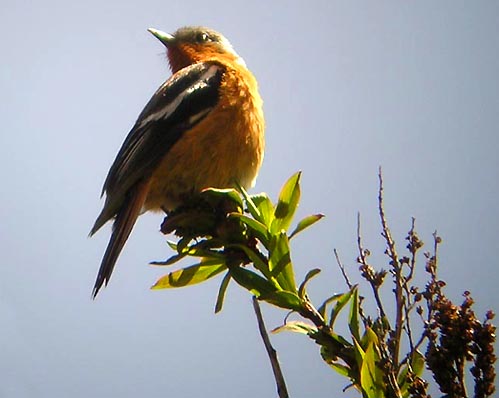 The
final species is another real stunner — and one of the major highlights
of the trip. It is Ala Shan Redstart P. alaschanicus (right),
a China endemic about which almost nothing is known. Paul Holt had only
once before glimpsed it here in "Paul's Canyon," and had never seen it
this well before. The species is not often photographed but this time both
David Fisher and I were lucky to get some fine digiscoped shots. Birdlife
International (2000) considers it "near threatened," noting that it is
known as a breeder only from Qinghai, Gansu and Ningxia provinces of China.
"Its breeding range and habitat requirements remain poorly understood because
of the sparse ornithological coverage of much of its range. . . It
appears to be rare, and has presumably been affected by habitat loss in
its breeding range." Its movements and wintering grounds are mostly unknown,
although there are winter records in lowlands of northeast China. The
final species is another real stunner — and one of the major highlights
of the trip. It is Ala Shan Redstart P. alaschanicus (right),
a China endemic about which almost nothing is known. Paul Holt had only
once before glimpsed it here in "Paul's Canyon," and had never seen it
this well before. The species is not often photographed but this time both
David Fisher and I were lucky to get some fine digiscoped shots. Birdlife
International (2000) considers it "near threatened," noting that it is
known as a breeder only from Qinghai, Gansu and Ningxia provinces of China.
"Its breeding range and habitat requirements remain poorly understood because
of the sparse ornithological coverage of much of its range. . . It
appears to be rare, and has presumably been affected by habitat loss in
its breeding range." Its movements and wintering grounds are mostly unknown,
although there are winter records in lowlands of northeast China.
It was certainly among the "most wanted" birds on the trip and to see
it so well — and get photos! — was a special treat. |



 Our
final two redstarts live in unexpected patches of scrub in dry, rocky,
remote canyons high on the Qinghai-Tibetan Plateau. This canyon (left)
is dubbed "Paul's Canyon" for Paul Holt who discovered the site near the
south shore of Qinghai Lake.
Our
final two redstarts live in unexpected patches of scrub in dry, rocky,
remote canyons high on the Qinghai-Tibetan Plateau. This canyon (left)
is dubbed "Paul's Canyon" for Paul Holt who discovered the site near the
south shore of Qinghai Lake. The
final species is another real stunner — and one of the major highlights
of the trip. It is Ala Shan Redstart P. alaschanicus (right),
a China endemic about which almost nothing is known. Paul Holt had only
once before glimpsed it here in "Paul's Canyon," and had never seen it
this well before. The species is not often photographed but this time both
David Fisher and I were lucky to get some fine digiscoped shots. Birdlife
International (2000) considers it "near threatened," noting that it is
known as a breeder only from Qinghai, Gansu and Ningxia provinces of China.
"Its breeding range and habitat requirements remain poorly understood because
of the sparse ornithological coverage of much of its range. . . It
appears to be rare, and has presumably been affected by habitat loss in
its breeding range." Its movements and wintering grounds are mostly unknown,
although there are winter records in lowlands of northeast China.
The
final species is another real stunner — and one of the major highlights
of the trip. It is Ala Shan Redstart P. alaschanicus (right),
a China endemic about which almost nothing is known. Paul Holt had only
once before glimpsed it here in "Paul's Canyon," and had never seen it
this well before. The species is not often photographed but this time both
David Fisher and I were lucky to get some fine digiscoped shots. Birdlife
International (2000) considers it "near threatened," noting that it is
known as a breeder only from Qinghai, Gansu and Ningxia provinces of China.
"Its breeding range and habitat requirements remain poorly understood because
of the sparse ornithological coverage of much of its range. . . It
appears to be rare, and has presumably been affected by habitat loss in
its breeding range." Its movements and wintering grounds are mostly unknown,
although there are winter records in lowlands of northeast China.















